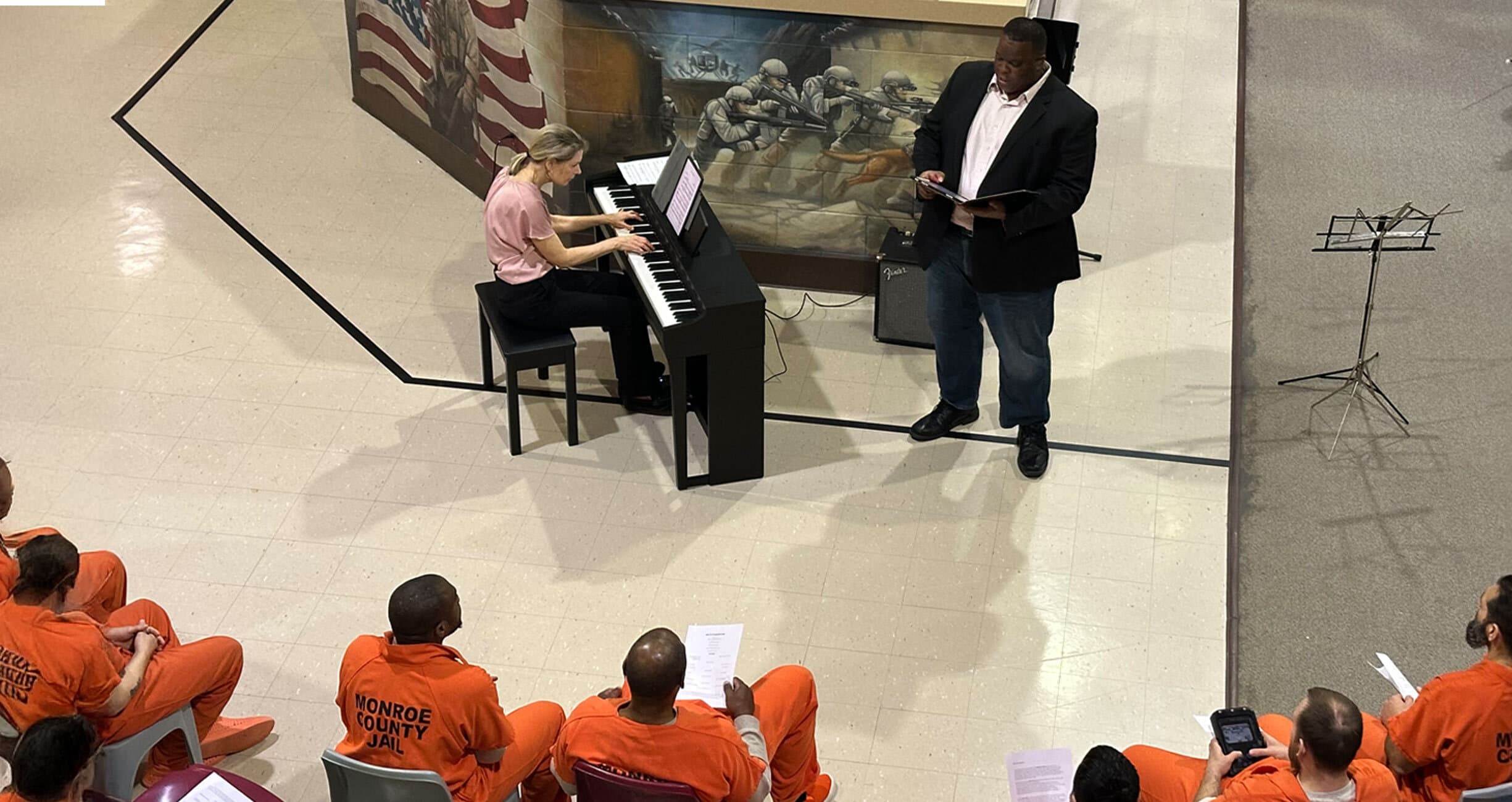The Power of Music for People in Jail and Prison
Positive programming can help uphold incarcerated people’s dignity, promote safety behind bars, and reduce recidivism.
It is not easy to get a piano into the Monroe County Jail in Upstate New York. But it is worth the effort, says Elinor Freer, director of ROC City Concerts, a concert series located near downtown Rochester that brings live performances to underserved populations throughout the city.
This educational initiative is funded by the Eastman School of Music’s John and Mary Celentano Endowed Chamber Music Fund. In early May, they performed at the local jail, as well as the Monroe County Children’s Detention Center, to bring live classical music’s transformative and therapeutic properties to those who may need it most.
“Music is one of the best tools we have to help us get in touch with our feelings,” Freer said. “It’s incredibly powerful what music can do.”
At Monroe County Jail, Freer and other musicians helped move an electric piano through the security airlock, along with a cello, saxophone, violin, and amplifier. They set up in a courtyard space next to the jail’s gym, surrounded by three stories of locked cells. As they warmed up and tuned their instruments, the music drew people to their six-inch glass windows.
“Music is such a part of our human core,” said Joshua Conyers, an opera singer and assistant professor of voice at the Eastman School of Music. “I don’t think anything is better for the soul and spirit.”
The United States currently incarcerates a staggering 1.8 million people, many of whom are housed in inhumane conditions, stripped of their dignity, and cut off from pathways to success. A disproportionate number of them are people of color. Most will be released one day, but will find themselves trapped in a cycle of perpetual punishment where they are denied housing and job opportunities—making it more likely that they will return to jail or prison.
Harsh and continuous punishment is no way to ensure someone’s success when they return home. In contrast, programming that promotes learning, creativity, and growth can help people heal and rebuild. And in recent years, some carceral facilities have had success embracing a culture of growth over punishment. Prioritizing people’s dignity behind bars—including through education, mentorship, meaningful work, enrichment, and recreation—leads to safer, healthier environments for people both living and working in carceral facilities, which also helps break cycles of incarceration.
Yet current federal efforts are moving in the opposite direction. President Trump has called for a return to failed “tough-on-crime” tactics, and the U.S. Department of Justice recently terminated more than $800 million in grants for programs that help reduce recidivism and support people after they leave prison—demonstrating a move away from evidence-based solutions to crime and safety.
While this regression at the federal level is deeply concerning, there are opportunities at the local and state levels to uphold incarcerated people’s humanity and to recognize that no one should be defined by their worst moments. For example, Vera’s Restoring Promise initiative has partnered with the departments of correction in Massachusetts and Oklahoma to launch Designed for Dignity, a project that provides training and technical assistance to corrections agencies seeking to create and sustain safer, more humane environments for incarcerated people and corrections staff. Designed for Dignity builds on the work that Restoring Promise has been doing with corrections agencies since 2016 to reimagine housing units for young adults with a commitment to human dignity.
“During slavery and some of the hardest times, people turned to music,” said Conyers, who sang the spirituals “Witness” and “Ain’t Got Time to Die” during the Monroe County Jail concert. “It shows the power of music when you are going through hard times.”
This spring, ROC City Concerts also performed for people recently released from prison who live in residential units at Spiritus Christi Prison Outreach Program, as well as people who are receiving treatment for mental health and substance use at East House Alexander Commons.
The jail concert ended with a trio for violin, cello, and piano by Ludwig van Beethoven. Beethoven composed the piece after losing his hearing and living through a period in which he considered suicide. “He wrote the kind of music that still speaks to people today about the struggles of being human,” Freer told the crowd.
When the piece concluded, the jail erupted with applause. Audience members asked questions about the instruments—and whether an older person could pick up the violin or the cello. “I enjoyed seeing the heart everybody put into it,” one concertgoer said during the discussion. “The love of what you are playing shows on your faces.”
